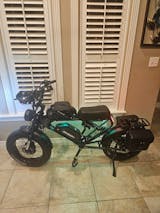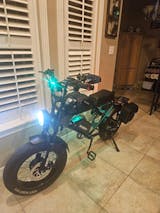Table of Contents
- What Determines an E-Bike's Speed Without Losing Efficiency?
- 1. Battery Capacity and Motor Power
- 2. Pedal-Assist vs. Throttle
- 3. Aerodynamics & Riding Position
- 4. Rolling Resistance and Tire Pressure
- Optimal Speed for Long-Range E-Bikes
- 1. What Is the Ideal Speed for Efficiency?
- 2. Factors Affecting Speed and Efficiency
- 3. Why Speed Balance Matters
- Practical Strategies to Keep Speed Without Draining Battery
- 1. Select the Appropriate Riding Mode
- 2. Keep Your Battery Healthy
- 3. Optimize Gear Usage & Cadence
- 4. Minimize Weight & Improve Bike Maintenance
- 5. Leverage Regenerative Braking
- Can You Ride a Long-Range E-Bike at High Speeds for Long Distances?
- 1. The Trade-Off Between Speed and Range
- 2. Can an E-Bike Maintain High Speeds Longer?
- 3. Common Myths About Speed and Efficiency
- Conclusion
- FAQs
Personal transportation has been revolutionized by electric bikes: an eco friendly form of efficiency, speed, and sustainability. Many riders who are on the quest for long range electric bikes want to know how fast you can travel, without having to sacrifice efficiency - speed is often linked with battery life, and if you are travelling too quickly your range will be limited.
Finding an optimal bike speed doesn't boil down to looking at its top speed alone; many factors, including motor efficiency, battery capacity, aerodynamics and riding behavior all play a part. Finding a balance is essential to ensure speed optimization without draining batteries too quickly; in this article we examine ideal speeds for long distance travel on electric bikes and how different riding styles impact efficiency while keeping up a good pace.
What Determines an E-Bike's Speed Without Losing Efficiency?
Many factors determine how fast an electric bike can travel without quickly depleting its battery, making understanding these components key in maintaining efficient riding experience and making the most out of each ride.
1. Battery Capacity and Motor Power
The high-capacity battery plays a significant role in determining both speed and distance for an e-bike ride. A larger battery stores more energy, but how effectively it provides power depends on its motor. Motor wattage also impacts power usage--higher-wattage motors can push faster speeds but may drain the battery faster without proper monitoring and management.
2. Pedal-Assist vs. Throttle
Riders frequently argue about pedal assist levels versus throttle use. While pedal assist provides motorized assistance while still requiring some pedaling, which improves motor efficiency; at higher speeds relying solely on throttle control can consume much more battery power; using pedal assist at moderate levels helps balance speed with range.
3. Aerodynamics & Riding Position
E-bike aerodynamics play an essential part in minimizing drag. Sitting upright increases wind resistance, forcing your motor to work harder; conversely, leaning forward reduces air resistance making maintaining speed easier with minimal energy usage.
4. Rolling Resistance and Tire Pressure
Tires can make or break an e-bike's efficiency. Proper tire care reduces rolling resistance, meaning less power must be expended by the motor to keep moving the bike along its intended path. Maintaining PSI levels according to manufacturer recommendations increases range while still sustaining speed.
These factors come together to determine how well an e-bike can maintain speed without draining its battery prematurely. Finding an optimal balance between power usage and riding habits makes all the difference in performance.
Optimal Speed for Long-Range E-Bikes
Locating the optimum speed range is vital to efficiently maintaining e-bike speeds without draining battery power too rapidly. While some e-bikes can reach up to 28 mph speeds, sustained at that pace over long distances it could significantly decrease range.
1. What Is the Ideal Speed for Efficiency?
Most electric touring bikes tend to find that optimal efficiency lies between 20-25 mph, whereby their momentum remains steady without incurring excessive energy losses or rapid depletion of battery power management resources.
2. Factors Affecting Speed and Efficiency
- Rider and Bike Weight: Extra heft requires additional power, decreasing efficiency.
- Terrain and Elevation: Uphill riding consumes more energy than flat roads.
- Wind Resistance: Strong headwinds force motors to work harder.
- Battery Maintenance: Ensuring proper battery management system maintenance will guarantee reliable performance of the batteries within it.
3. Why Speed Balance Matters
Exploiting an e-bike's maximum speed frequently may seem appealing, but doing so will reduce battery life and require more frequent charging sessions. Riding within a steady speed range provides longer distance per charge experience without constant worry over battery capacity.
Maintaining an eco-friendly approach to e-bike travel by staying within this efficiency range allows riders to enjoy long distance e-bike travel without compromising power or durability.
Practical Strategies to Keep Speed Without Draining Battery
To maximize an e-bike's range optimization, riders must implement strategies that balance speed and energy efficiency. Here are a few proven techniques that will keep their speed without quickly depleting battery life.
1. Select the Appropriate Riding Mode
Most e-bikes feature multiple riding modes, such as eco, normal, and sport. Choosing eco or mid-level pedal assist levels instead of full throttle mode helps conserve power while maintaining steady speeds.
2. Keep Your Battery Healthy
Proper battery care ensures consistent performance. Here are the best practices:
- Charge before the voltage falls below 20% to extend lifespan.
- Store at room temperature to prevent performance degradation.
- Use a charger compatible with your battery management system so as to prevent overheating.
3. Optimize Gear Usage & Cadence
Efficient pedaling using appropriate gear ratios will reduce motor workload. A cadence sensor helps ensure an even pedaling rhythm to optimize power usage at higher speeds.
4. Minimize Weight & Improve Bike Maintenance
- Carry only necessary items to reduce load and maximize speed optimization on an e-bike.
- Test torque sensors regularly for smooth power delivery.
- Keep the drivetrain clean and lubricated to reduce energy loss.
5. Leverage Regenerative Braking
But some e-bikes have regenerative braking technology, which helps to recover some energy whilst slowing down. While not fully charging the battery, regenerative braking will add travel over longer trips.
By putting these tips to use, riders will get efficient e-bike speeds and arange for longer, more enjoyable rides with the battery life remaining intact.
Can You Ride a Long-Range E-Bike at High Speeds for Long Distances?
However, riders often ask the question if they can hit a long range electric bicycle at its top speeds while riding long distances and the answer to this question depends on a number of variables including battery capacity, motor efficiency and different riding conditions.
1. The Trade-Off Between Speed and Range
Bikes that rely on electricity may only go as fast as 28 mph, but continuous operation at that speed will rapidly drain the reserves of a battery. The best strategies to optimize battery performance and increase rider battery life have been demonstrated to be the cruising speeds of 20-25 mph — it’s more efficient than other speeds. At higher speeds the needed power increases and range decreases.
2. Can an E-Bike Maintain High Speeds Longer?
- Large Battery Capacity: For optimal speed over longer distances, an e-bike battery with an increased capacity (such as 1000Wh or greater) allows higher speeds at higher intensities.
- Efficient Motor and Assist Levels: Optimizing motor efficiency settings with pedal assist ensures more even power distribution compared to full throttle cycling.
- Flat, Paved Roads: Reduced rolling resistance on smooth terrain helps conserve battery power.
- Lightweight Setup: Carrying minimal weight improves overall efficiency.
3. Common Myths About Speed and Efficiency
Many assume that traveling at top speeds is the only effective way of covering long distances quickly, yet consistent speed control and smart power management strategies result in more practical and efficient rides. Switching between moderate pedal assist and coasting to conserve battery power.
Focusing on sustained speed rather than peak speed when planning long-distance e-bike travel ensures optimal performance without compromising efficiency.
Conclusion
Long-range electric bicycles don't always combine speed with efficiency. Some of the electric touring bikes do hit a top speed of 28mph, but doing so for long distances will quickly drain their huge high capacity battery pack.
E-bike speeds should ideally fall anywhere from 20 mph to 25 mph, where these riders can cover more of the ground without having to expend as much energy. Contributions to maintain speed and range efficiency both include motor efficiency, rolling resistance and proper battery management system maintenance.
Long distance e-bike traveling is more practical and enjoyable if a steady and controlled pace is maintained without losing performance or longevity. Our final refinements or additions?
FAQs
1. Which speed should an e-bike travel at to maintain efficiency over its entire travel range?
For a long range e bike ideally between 20-25 mph is the aim in order to strike a balance between efficiency and battery life, to save battery for longer trips without frequent recharges.
2. How does riding speed influence an e-bike's battery range?
High speeds increase air resistance and motor workload, leading to faster battery depletion. Meanwhile, at moderate speeds energy consumption drops, prolonging its range per charge.
3. How can I reach maximum speed without significantly decreasing my e-bike's range?
Maximal speeds often lead to significant battery drain, thus decreasing overall range. To balance speed with efficiency, it is advisable to ride at moderate speeds while employing pedal-assist modes effectively.





















